Laptop Mag Verdict
The $299 Boost Max is a solid no-contract phablet value, with a 5.7-inch display, handy split-screen software and impressively long battery life.
Pros
- +
SmartView software splits screen between any two apps
- +
Large and colorful 720p screen
- +
Superior Dolby speakers
- +
Very long battery life
- +
Great value
Cons
- -
Sluggish LTE speeds
- -
Mediocre call quality
Why you can trust Laptop Mag
Want a big screen without the big commitment? Boost Mobile has added to its line of no-contract devices with the exclusive ZTE-made Boost Max. The 5.7-inch phablet provides Snapdragon S4 performance in a premium build for $299. Its SmartView software splits your screen between any two apps for improved multitasking, while a ZTE-created MiFavor UI adds nifty lock-screen features to the Android 4.1.2 device. Add to that, superior Dolby Digital Plus speakers and more than 10 hours of battery life, and you have one of the best Boost bargains yet.
Design
You can't tell the Boost Max is a budget phablet just by looking at it. Its all-black Gorilla Glass front is an eye-catching dark surface with touch-sensitive Back, Home and Menu keys at the bottom. A smooth, silver-like finish on its plastic back adds a touch of class, and its curved edges make the phone easy to hold.
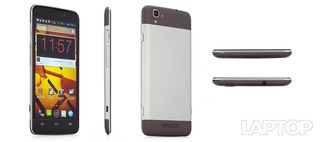
The Boost Max's back comprises a silver, rectangular panel flanked by two thumb-width charcoal segments on the top and bottom. Nestled in the top left corner is the Max's 8-MP camera and LED flash, while the speaker sits on the bottom. Along the right edge is a three-dot wireless charging conductor that's compatible with Qi wireless charging cases. Pop off the panel covering the camera, and you can access the micro SIM slot underneath it.
On the left edge of the Max are a microSD slot, volume rocker and microUSB port, while the right side houses a dedicated camera shutter and a power button. A 3.5mm headphone jack sits up top.
MORE: Top 10 Smartphones
At 6.29 x 3.23 x 0.37 inches, the Boost Max is smaller than the 6.6 x 3.5 x 0.3-inch Samsung Galaxy Mega and the 6.47 x 3.24 x 0.4-inch HTC One Max. Granted, the latter two have bigger screens, which measure 6.3 inches and 5.9 inches, respectively. Weighing 7.05 ounces, the Boost Max is a hair heavier than the Mega (7 ounces) but lighter than the One Max (7.65 ounces).
Display
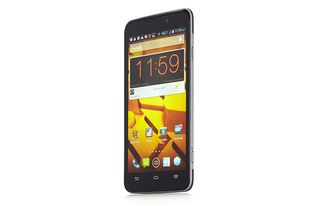
Click to EnlargeWe were pleasantly surprised by the quality of the Boost Max's 5.7-inch, 1280 x 720p IPS capacitive display. Watching a 1080p trailer for "Robocop 2014" was a visual treat. The red of Robocop's helmet and the oranges of an explosion really popped. Details were so clear we could see the burn wounds on Joel Kinnaman's battered body. Viewing angles were wide, but images washed out at extreme angles.
The Boost Max has the same 1280 x 720p resolution as the Mega, but falls short of the One Max's 1080p display. Registering 389 lux on our brightness meter, the Boost Max's screen is dimmer than the average smartphone (408 lux), the Galaxy Mega (398 lux) and the One Max (441 lux).
Audio
The Max's rear-mounted speaker delivered booming audio in our tests. We played "Do You Hear the People Sing" from the "Les Miserables 10th Anniversary" soundtrack and enjoyed beautifully clear voices free of distortion, although top notes were somewhat flat. The music filled a small meeting room with sound.
The Dolby Digital Plus app has four preset profiles -- Movie, Music, Game and Voice -- and two that you can customize. When we played "Bewitched, Bothered and Bewildered" by Linda Ronstadt and switched among the four default profiles, we found that the Movie and Game modes delivered better volume and quality. The Movie and Game modes also offered a more enjoyable sound experience when we played "N.O.V.A. 3," with gunshots and background noises sounding more distinct than they did in Music and Voice modes.
The Boost hit 76 dB on Laptop Mag's Audio test, which involves playing a tone and measuring it from 13 inches. That's softer than the average smartphone (80 dB), the Mega (83 dB) and the One Max on Verizon (83 dB).
Keyboard
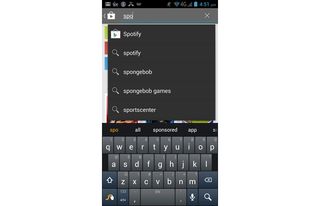
Click to EnlargeThanks to its width, the Boost Max accommodates a well-spaced QWERTY keyboard with generously sized keys. An orange highlight appears on each key as you hit it, and the keyboard offers gentle haptic feedback, making typing feel more realistic. The phone also offers Swype trace typing, Google voice input and next-word prediction.
For a phone this size, it's unfortunate that ZTE did not offer a one-handed operation mode. The Samsung's Galaxy Mega and the HTC One Max both have this handy option.
Software and User Interface

Click to EnlargeRunning Android 4.1.2 Jelly Bean, the Boost Max is light on special software features. The most obvious tweak is the device's lock screen, skinned with ZTE's MiFavor UI, which greets you with a clock widget and three round buttons on a wallpaper of multiple Boost logos. The three buttons let you quickly access the Camera app, unlock the phone and switch between Vibrate and Ringing modes by holding down the respective icons.
ZTE does not include the ability to customize the lock screen on the Boost Max (you'll find this feature on its other phones such as the Grand S), so you're stuck with the three preset lock-screen buttons.
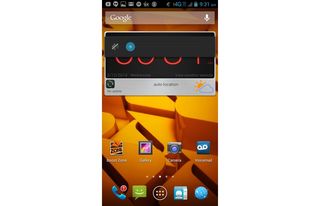
Click to EnlargeA plain orange-on-black clock widget is at the top of the home screen, while five shortcut icons line the bottom, providing quick access to Phone, Messages, All Apps, People and Browser. You can rearrange and customize these icons by holding and dragging them around.
MORE: 12 Worst Android Annoyances and How to Fix Them
Swiping from the top reveals a notifications menu, with a row of four buttons at the top to quickly toggle settings for Wi-Fi, Smart Viewer, Airplane Mode and Auto Rotate. A down arrow at the end of this row opens a second layer of quick settings such as Sync, Sound, Bluetooth, Data and GPS, as well as a brightness slider. You can also change your input method and wallpaper from here.
Although the phone runs an old version of the Android OS, Boost and ZTE expect to release a KitKat update for the phone within the year.
SmartView
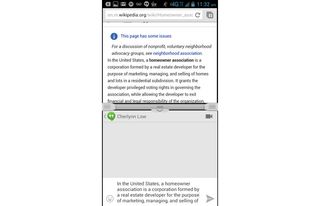
Click to EnlargeLike other Samsung and LG products, ZTE includes split screen software on its phablet to better use the real estate. SmartView lets you split the screen between two apps so you can look at the content of both at the same time. But while you can only open about 20 supported apps in Samsung's Multi Windows and 13 in LG's Dual Window, the Boost Max lets you launch any app on your phone with SmartView.
Tapping and holding the back button opened a floating SmartView panel, in which all the apps on our phone were laid out in a grid. We long-tapped an app's icon and dragged it out of the box to open it. Doing the same with another app opened it on half of the screen; the other app was simultaneously resized. We liked being able to copy and paste parts of a Wikipedia page into a chat on the Hangouts app without having to switch screens.
However, ZTE's split-screen feature isn't as robust as competitors' versions. For example, you can't drag-and-drop an image from your Gallery into an email or text message, as you can with Samsung's Multi Window feature. You also can't split the screen between two instances of the same app -- such as two Chrome windows -- as you can on the newer versions of Multi Window.
Performance
The Boost Max's 1.2-GHz dual-core Snapdragon MSM8930 processor with 1GB RAM proved snappy when performing everyday tasks. We played a round of "N.O.V.A. 3" without hiccups, while Gallery, Hangouts, Chrome, Phone, Gmail and Settings ran in the background. Returning to the home screen from apps took two seconds, and the camera smoothly snapped several photos within a second, without delay. Changing orientations from portrait to landscape and vice versa was fast enough, taking 2 seconds.
However, on our standard suite of benchmark tests, the Boost Max did not perform well against its competition. For example, the first-person shooter app "N.O.V.A. 3" loaded in 22 seconds on the Boost Max, slower than on the average smartphone (15 seconds), the One Max (16 seconds) and the Galaxy Mega (17 seconds).
The Boost Max's score of 770 on Geekbench 3 is well below the smartphone category average (1,673), the Snapdragon 600-powered One Max on Verizon with 2GB RAM (1,867) and the Qualcomm MSM8930AM-powered Mega with 1GB RAM (1,129).
Transcoding a 205MB video from 1080p to 480p with VidTrim took a long 10 minutes and 22 seconds. That's nearly 2 minutes longer than the average smartphone (8:10), and much slower than the Mega (7:39) and the One Max (7:33).
Graphics-wise, the Boost Max couldn't match its biggest rivals, either. It scored 6,599 on An3DBench, lower than the smartphone category average of 7,430, the Mega's 7,451 and the One Max's 7,607.
Apps
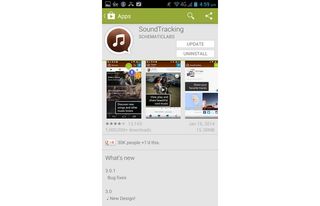
Click to EnlargeOut of the box, the Boost Max is thankfully free from bloatware. From Boost, you get just Boost ID, Boost Music, Boost Zone and the Boost Discover It widget that displays recommended apps on your home screen. Third-party apps include Dolby Digital Plus and Kingsoft Office.
MORE: 25 Best Android Apps
The standard set of Google apps is also here: Hangouts, YouTube, Phone Top Search, Gmail, Play Magazines, Google Wallet, Google Maps and Chrome.
Camera and Camera App

Click to EnlargeThe Boost Max's 8-MP rear camera is capable, but isn't among our favorites. Pictures we snapped were clear and the colors were accurate, but we preferred those taken with the Mega and One Max. In a photo of a New York City intersection, the reds and blues on American flags hanging off a building were deeper on the Galaxy Mega than on the Boost Max. The One Max delivered paler tones than both the Boost and the Galaxy in the same picture, but showed deeper blacks.
We saw crisp details and bright colors in a 1080p video we recorded on the Boost Max. The colorful red, green and yellow signs in Time's Square during the day stood out against the dreary gray buildings they adorned, and the camera capably adjusted to lighting changes.
[sc:video id="I2aXE1cTorzi_fXrvWtoqHKXnCQBcmdk" width="575" height="398"]
The 1-MP front camera took passable selfies. Our bright red sweater appeared vivid, while our hair highlights exhibited accurate color. The messy stray hairs sticking out of our head were also well defined.
We like the dedicated Camera button on the Max's right edge, as we were able to take pictures of New York City in the throes of a blizzard without having to remove our gloves.
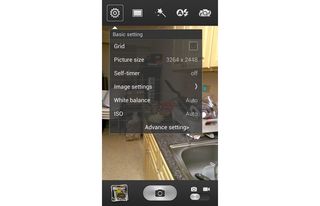
Click to EnlargeThe ZTE-modified camera app lets you change some settings -- such as white balance, exposure and picture size -- from a Gear button on the viewfinder screen. You can also shoot in Pro mode, which offers options such as Smile shot (auto-captures when it detects a smile in your frame), Reprojection (which straightens slanted pictures) and Blink Detect (which snaps a shot only when all eyes are open). Basic shooting mode offers the standard Panorama, HDR, Low Light and Best Shot modes.
You can also add one of 11 filters such as Sepia, Monotone, Negative, Emboss, Neon and Aqua. Unfortunately, the Max lacks the myriad camera features found on Samsung phones, such as Sounds & Shot mode on the Galaxy Mega and Eraser mode on the Galaxy S4.
4G LTE
Boost Mobile relies on Sprint's 340-market 4G LTE network, which is smaller than AT&T's 476-strong footprint and Verizon's network, which covers more than 500 markets.
In a Hell's Kitchen apartment with five to six bars of 4G LTE service, the Boost Max delivered miserable average speeds of 2.29 Mbps up and 1.82 Mbps down on the Speedtest.net app. The image-heavy Laptopmag.com took a whopping 18.1 seconds to fully load, while the NYTimes.com mobile site loaded in 6.5 seconds.
Speeds were similarly slow in our Flatiron district offices, with Speedtest numbers showing 2.5 Mbps down and 0.3 Mbps up on average (one to two bars of 4G LTE signal). Also note that the Boost Max cannot tap into Sprint's higher-speed Spark service.
Battery Life and Call Quality
Packing a large, 3,200-mAh battery, the Boost Max lasted an impressive 10 hours and 10 minutes on the Laptop Battery test (continuous Web surfing over 4G at 40 percent brightness). That's 3 hours longer than the average smartphone (6:55). The Galaxy Mega's 3,200-mAh battery (7:13) and the One Max's 3,300-mAh battery (8:32) on Sprint's network didn't last anywhere near as long.
MORE: 10 Smartphones with the Longest Battery Life
Voice calls were slightly muffled on the Boost Max. A friend in the Bronx reported being able to hear us clearly for the most part, but we experienced some distortion in their voice. On speaker, our friend reported some muffled audio, but we could understand each other fine.
Plans and Pricing
For a limited time (sign up by March 31, 2014), Boost Mobile offers unlimited talk, text and 4G LTE at just $35 a month for the first six months (after which your monthly payment goes up to $50). Combined with Boost's Shrinking Payments plan that whittles $5 off your monthly fee per every six on-time payments, the Boost Max will set you back $1,319 including the $299 handset cost. If you miss the promotion, Boost Mobile's regular monthly, unlimited plan gives you unlimited talk, text and data for $55 a month. With the Boost Max, that adds up to $1,439 over two years with 12 on-time payments (including handset cost).
By comparison, the Galaxy Mega costs $149 with a two-year agreement on Sprint. On Sprint's Unlimited My All-In plan, you get unlimited talk, text and data for $110 monthly. That's twice Boost's regular monthly fee. On the My All-In plan, the Galaxy Mega will cost $2,789 over two years. The HTC One Max on Sprint is $100 more with its $249 upfront fee, thus running you $2,889 in two years. That's over $1,000 more than the two-year cost of the Boost Max.
Verdict
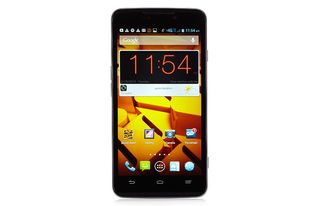
Click to EnlargeWhile it's not the fastest smartphone in its class, the $299 Boost Max is still a very good value. This 5.7-inch device offers a quality 720p screen, good audio quality and very long battery life. We also like the split-screen multitasking feature. If faster 4G speeds are important to you, you might want to consider a phablet on a different carrier, such as the AT&T Galaxy Note 3. But in the no-contract phablet space, the Boost Max is a smart buy
Boost Mobile Boost Max Specs
| Brand | Boost Mobile |
| CPU | 1.2-GHz dual-core Qualcomm Snapdragon MSM8930 |
| Camera Resolution | 8 MP |
| Carrier | Boost Mobile |
| Company Website | http://www.boostmobile.com/shop/phones/boost-max/ |
| Display (main) | 5.7 inch 1280 x 720p IPS |
| Display Resolution | 1280x720 |
| Form Factor | Candy Bar |
| Front Camera Resolution | 1 MP |
| Memory Expansion Type | microSD Card |
| Networks | EVDO BC0/BC1/BC10 LTE Band 25 |
| OS Family | Android |
| Operating System | Android 4.1.2 |
| Phone Display Size | 5.7 |
| Ports | microUSB, microSD, 3.5mm headphone, Wireless Charging Port |
| Processor Family | Qualcomm Snapdragon MSM8930 |
| RAM | 1GB |
| Size | 6.29 x 3.23 x 0.37 inches |
| Talk / Standby Time | 16 hours |
| Weight | 7.05 ounces |
| Wi-Fi | 802.11 a/b/g/n |
